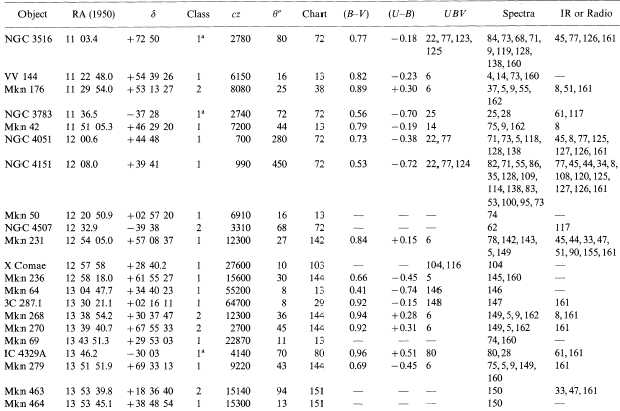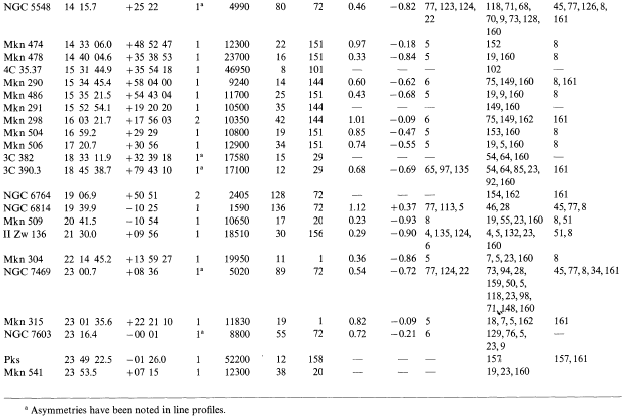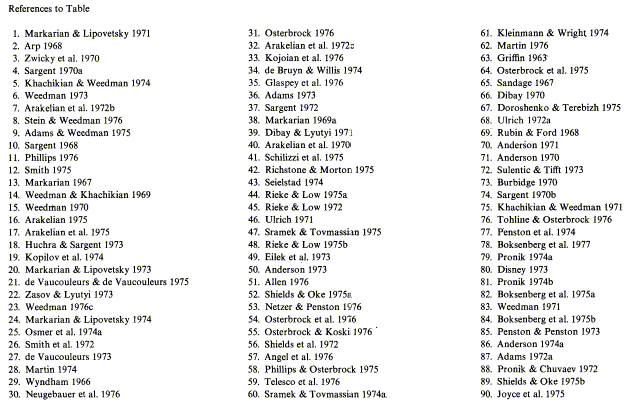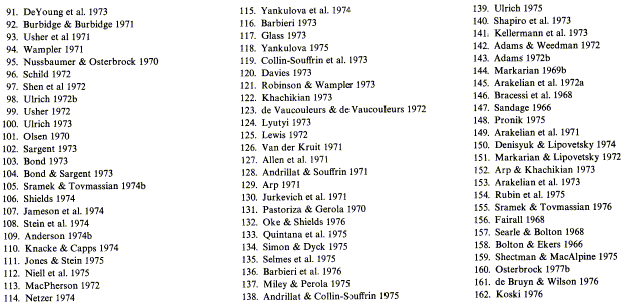Copyright © 1977 by Annual Reviews. All rights reserved
| Annu. Rev. Astron. Astrophys. 1977. 15:
69-95 Copyright © 1977 by Annual Reviews. All rights reserved |
After looking at only a few galaxies through a telescope, the distinctive properties of Seyfert galaxies are readily apparent. An ordinary galaxy, spiral or elliptical, has a concentration of light in the center which is usually called a "nucleus." In such cases, there is a gradual brightening of the galaxy toward the nucleus, and the surface brightness at the center is much fainter than that of a star whose magnitude is comparable to the total magnitude of the galaxy. In any photograph, no matter how short the exposure, such a galaxy looks fuzzier than a star. A Seyfert galaxy, however, can readily be recognized at the telescope (which greatly simplifies the use of finding charts) because it looks like a bright star surrounded by a faint envelope. In short-exposure photographs, it cannot usually be distinguished from a star. Consequently, the morphological definition of a Seyfert galaxy is the presence of an unresolved, very bright nucleus. The extent to which the nucleus dominates the galaxy depends both on the nucleus/galaxy luminosity ratio and the distance to the system. Beyond redshifts of about 0.1, objects bright enough to have been identified as Seyferts probably have a nucleus so dominant in photographs that the galactic envelope is unclassifiable. While the lowest redshift Seyferts have been classified morphologically, there have been only limited attempts to define Seyfert galaxies on the basis of their photographic appearance (de Vaucouleurs & de Vaucouleurs 1968, Morgan et al. 1971). There are few direct measures of the actual sizes of Seyfert nuclei. The largest (NGC 1068) has emission lines arising over a region 8" in diameter (Walker 1968) although the continuum source is unresolved. Photographs of NGC 4151 from a balloon-borne telescope give an upper limit of 0".08 to the diameter of the continuum source (Schwarzschild 1973). VLBI results for 3C 120 measure individual radio sources, which presumably are no smaller than the optical source, to be as small as 0".001 (Kellermann et al. 1973). Many Seyfert nuclei are variable in brightness on time scales of years, which sets limits to their sizes if light-travel-time arguments are used.
There is also a spectroscopic definition of a Seyfert galaxy, which requires that they have strong and broad emission lines in their spectra (Seyfert 1943). Such lines are never seen in galaxies without bright nuclei, but there are some galaxies with bright nuclei that do not have such emission lines. In my experience, there are no galaxies without Seyfert spectroscopic characteristics whose nuclei are as bright relative to the galactic disk as they are in Seyferts. However, this opinion has not been quantitatively verified. Certainly, the presence of a compact luminosity source is a necessary prerequisite for having broad emission lines. This spectroscopic definition seems uncomfortably qualitative until it is realized that there are few ambiguous cases. Many galaxies have emission lines in their spectra, but these are generally narrow lines with widths less than a few hundred km sec-1. Seyfert galaxies have emission lines with full widths of 103 km sec-1 or more, which means that only in a few cases is it necessary to argue whether an emission line is broad enough to call a galaxy a Seyfert. Astrophysically, the broad emission lines are just one indication of the activity that distinguishes Seyfert galaxies. There are other properties that are found to correlate with the Seyfert definition, such as the nature of the continuous spectra.
It is inappropriate to include too many parameters within a definition,
so for this review a Seyfert galaxy is considered to be any object
appearing nonstellar (nebulous)
in photographs and having broad emission lines in its spectrum. This can
include N galaxies as well as objects called QSOs, if they are
accompanied by surrounding
nebulosity. The implication will be that the nebulosity is in fact the
disk of a galaxy,
but this requires proof and so is irrelevant to the observational
definition. Because the most homogeneous photographic data generally
available for galaxies is that of
the National Geographic Society - Palomar Observatory Sky Survey,
the working definition of a Seyfert galaxy in this review requires that
it appear nonstellar on the
Sky Survey. This means in practice that it must have a diameter
greater than about
7" for the nebulosity around the nucleus to be visible. We
therefore are not including
objects occasionally called galaxies because improved photographs show
nebulosity associated with them (e.g.
Kristian 1973).
In Table 1, a list is given of 88 Seyfert
galaxies that satisfy our working definition. This list is an update of
that given by
Khachikian & Weedman (1974)
with 23 galaxies having been added and 6 deleted
because there was uncertainty in their initial classification as
Seyferts. Other than
such updating, the differences between Table 1
and the Seyfert listing by
Vorontsov-Velyaminov &
Ivanisevich (1974)
arise because the latter authors include a number
of narrow-line galaxies. The listing in
Table 1 is conservative, generally omitting
galaxies referred to by spectroscopists as probably or possibly being
Seyferts unless
UBV photometry also showed the characteristic Seyfert
colors. Galaxies are included
only if a published reference contains their Seyfert designation,
although a few unpublished Seyferts exist in various private
collections. Redshifts are given in
km sec-1, as cz. The UBV colors are given for
the smallest apertures used so as to
represent primarily the nuclei. Magnitudes are not listed because they
are dependent
both on aperture and epoch. Most are between 14 mag and 16 mag although a
few NGC objects are as bright as 11 mag. Angular diameters
 " are the maximum
diameters that I measured on the Sky Survey prints, except for a
few southern objects for which other photographs were used. References
to photometry, spectroscopy,
and other studies are usually included only for work published since 1970.
No morphological properties are listed in
Table 1 because these are summarized by
Adams (1977).
This list is intended to include those Seyfert galaxies reported
in the literature before Sept. 1, 1976, but will certainly be incomplete
when published.
For example, two new Markarian lists (through the 800 series) were in
press as of this date and may contain perhaps 20 more Seyfert galaxies.
" are the maximum
diameters that I measured on the Sky Survey prints, except for a
few southern objects for which other photographs were used. References
to photometry, spectroscopy,
and other studies are usually included only for work published since 1970.
No morphological properties are listed in
Table 1 because these are summarized by
Adams (1977).
This list is intended to include those Seyfert galaxies reported
in the literature before Sept. 1, 1976, but will certainly be incomplete
when published.
For example, two new Markarian lists (through the 800 series) were in
press as of this date and may contain perhaps 20 more Seyfert galaxies.

|

|

|

|

|

|